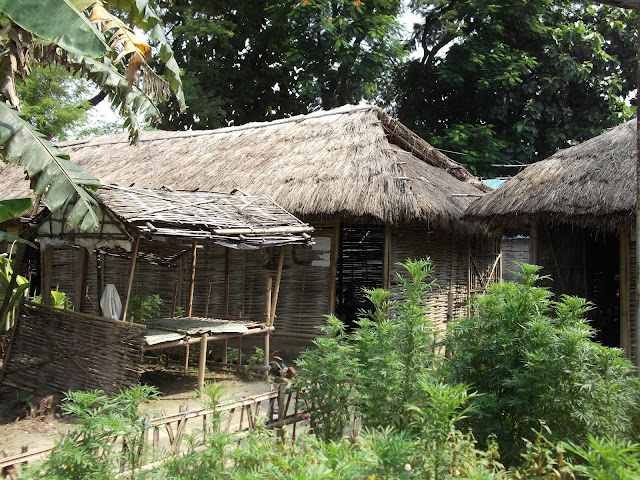I have had the great privilege of visiting the Bhutanese Refugee Camps outside of Damak, Nepal. In the US, I have been working and volunteering with newly-arrived Bhutanese refugees and have grown quite close to many of them. Because of this strong relationship, I wished to visit the camps and get a small taste of what life is like there. Here, I will attempt to honestly express my experience there. Since it was a very short visit, my impressions may not accurately reflect the camps.
Currently there are four refugee camps, all located near the town of Damak in the eastern Terai region. The camps are overseen by the UNHCR (UN Refugee Agency).The refugees have been living there for more than twenty years.
The houses or "huts" are made of bamboo and thatch.
Fire is a great threat to the homes of the refugees and there have been many fires which destroy tens if not a hundred homes. When their home is lost, the refugees sometimes must live in the nearby jungle for up to a month while a new hut is built.
Another threat to the huts and the lives of the refugees is elephants. The jungle is nearby and at least once a year and elephant or two will wander out to steal food, especially salt. I was told that in the past five years, elephants have killed around 15 people, and destroyed numerous huts.
Some families own shops that sell a variety of goods, from snacks, to hair clips to basic medicine.
Electricity is not provided and comes from solar panels (see above on roof) which the refugees must buy themselves. If they don't buy a solar panal, then they don't have electricity in their home.
Caritas Nepal provides free education (including supplies and one uniform) up until class 10, at which point they must pay to go to college or university outside of the camp if they want to continue their studies. I visited the school and several classes.
 |
| Eighth Grade |
 |
| Eighth grade |
 |
| First Grade |
 |
| School Grounds |
There is also a variety of training programs, such as mechanics, teaching, sewing, and electronic repair. I sat in on a couple of beauty parlor training classes.
 |
| "Butterfly" |
Employment options in the camp are very limited. The refugees aren't supposed to seek outside employment but many do, sometimes in faraway towns. However, once they start the resettlement process they must be able to report often and thus it is not possible to work far from the camp at that point.
The UNHCR and Lutheran World Federation (LWF) provide rations to the camp residents. Every two weeks they receive rice, sugar, salt, pulse (lentils), vegetable/palm oil, and 'super cereal'. There are some community gardens in the camps where vegetables are grown. Some families have pigs or other livestock that they can use for food. But in general, vegetables and meat must be bought.
Water comes from taps for two hours every morning, and two hours every evening. The water is filtered and considered safe for drinking. Around 60 huts share each tap. Between 6-10 people live in each hut.
There are a variety of programs in the camp, including:
- Bhutanese Refugee Womens Forum - provides help to women suffering from domestic abuse
- Youth Friendly Center - provides trainings and sports for youth
- Childcare Center - helps orphans and children whose parents have alcohol additions
- Happy Nepal - assists with mental health and alcohol and drug additions
- And certainly others....
There are many recreational activities in the camp, including sports such as soccer (football), volleyball, badminton, table tennis and cricket.
 |
| Soccer Match |
The camps have health centers which provide free care for basic treatment, while more serious ailments are sent to the hospital in Damak. For very serious cases they are sent to a hospital in a larger town such as Biratnagar. Common diseases in the camps are TB, diabetes, and pneumonia, especially in children. If someone has cancer or a serious disease, their resettlement process will quicken.
Nearly every single person I met was in the process of resettlement and knew their destination. Most go to the US but some also go to Australia, Norway, Denmark, and other Western countries. For the most part, people go where their family has already resettled. Over 60,000 Bhutanese refugees have resettled in the US alone since 2008 when they began to leave the camps.
Despite the close living quarters, from my impression theft and violence did not seem to be very frequent. There is a great sense of community in the camps, where everyone knows each other and looks out for one another. The spirit is very hopeful and positive, at least from my impression.
I am very grateful to have had the opportunity to visit the refugee camps and be welcoming by the incredibly kind, hopeful and generous people there.





















































